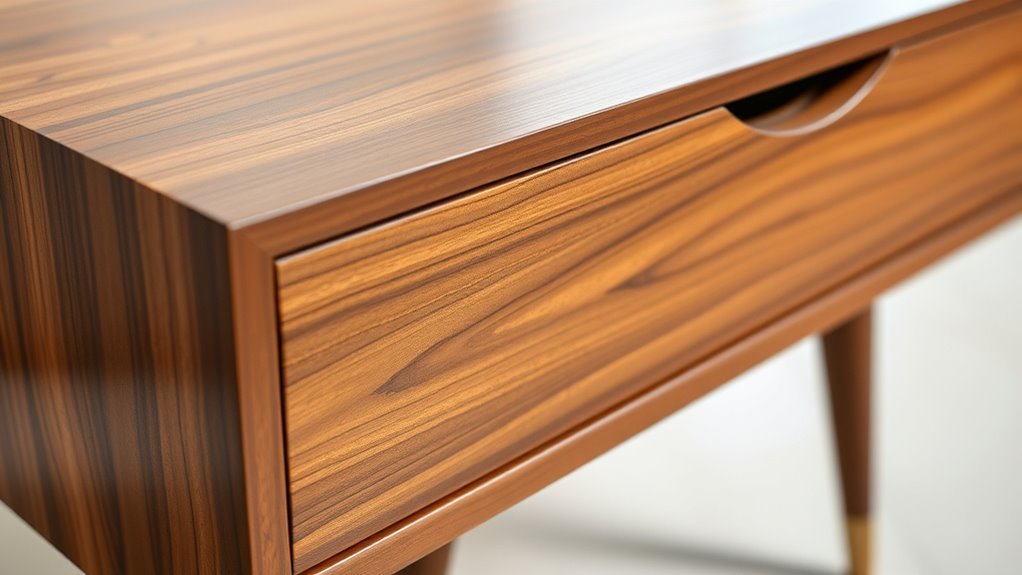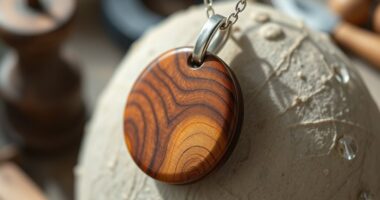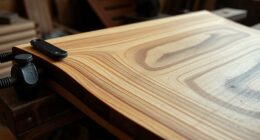You can learn timeless mid-century joinery techniques like dovetail joints, mortise and tenon, and finger joints that combine strength with sleek design. Focus on working with quality materials such as teak, walnut, or oak, and master precise cuts for tight-fitting joints that age beautifully. Emphasize clean lines, smooth surfaces, and simple finishes to capture the era’s minimalism. Keep exploring, and you’ll discover how these traditional methods bring both durability and elegance to your furniture projects.
Key Takeaways
- Master traditional joinery techniques like dovetail, mortise and tenon, and finger joints to achieve authentic mid-century furniture strength and elegance.
- Learn precise cutting and fitting methods to create tight, seamless joints that enhance durability and minimalist aesthetics.
- Use natural materials such as solid wood, plywood, and veneer, considering grain and texture for harmonious designs.
- Incorporate clean lines and minimal ornamentation with carefully planned joints to reflect mid-century functional beauty.
- Develop surface finishing skills like sanding, oiling, or lacquering to emphasize craftsmanship and aging patina over time.

Mid-century joinery designs embody a sleek, functional aesthetic that has stood the test of time. When you explore into this style, you notice how craftsmanship and material choices elevate simple forms into iconic pieces. At the core of these designs are crafting techniques that emphasize precision and durability. You’ll want to master traditional joinery methods like dovetail joints, mortise and tenon, and finger joints, which not only guarantee strength but also add visual interest. These techniques require careful planning and skill, but they’re fundamental to achieving the clean, seamless look characteristic of mid-century furniture. As you work, pay close attention to how each joint fits perfectly, creating a sturdy framework that ages gracefully. Incorporating traditional joinery methods ensures your furniture is both beautiful and long-lasting, reflecting the quality craftsmanship of the era. Material selection plays an equally crucial role. Mid-century designers favored natural materials such as solid wood, plywood, and veneer, which offered both aesthetic appeal and practical benefits. When choosing your materials, consider the grain, color, and texture—these elements contribute to the overall harmony of your piece. Woods like teak, walnut, and oak were popular choices because they’re durable and develop a rich patina over time. Plywood became a favorite for its strength and versatility, allowing for curved forms and streamlined shapes. You should prioritize quality materials, as they directly influence the longevity and beauty of your finished work. Incorporating these crafting techniques and material choices, you can replicate the elegant simplicity of mid-century joinery. Focus on clean lines, minimal ornamentation, and functional design—hallmarks of the era. When you cut joints, do so with precision, ensuring tight fits that require minimal finishing and provide maximum strength. Sand surfaces smoothly to highlight the natural beauty of the wood, and consider using oil or lacquer finishes that enhance grain and protect against wear. As you learn and apply these techniques, remember that the key to authentic mid-century joinery is balance. It’s not just about how the pieces come together but also about how they look and feel. Your craftsmanship should reflect a respect for tradition while embracing modern sensibilities. With patience and attention to detail, you can create furniture that’s both timeless and functional, embodying the enduring appeal of mid-century design. This approach not only elevates your craftsmanship but also guarantees your pieces will be admired for generations.
Frequently Asked Questions
What Tools Are Essential for Mid-Century Joinery Projects?
For mid-century joinery projects, you’ll need essential joinery handtools like chisels, saws, and screwdrivers. Woodworking jigs are also crucial to guarantee precision and consistency. A good square, measuring tape, and clamps help you assemble pieces accurately. These tools allow you to craft clean, durable joints characteristic of mid-century design, making your projects both functional and timeless. Mastering these tools elevates your woodworking craftsmanship.
How Do I Choose the Right Wood for Durability?
Thinking about durability? Well, don’t just pick any wood—your furniture’s future depends on it. You should consider the wood grain’s strength and how well it withstands wear. Also, invest in proper wood treatment; it’s like giving your wood a superhero cape. Choosing the right wood isn’t rocket science, but ignoring these details might leave you with a fragile, sad piece instead of a timeless masterpiece.
Are There Modern Techniques That Mimic Mid-Century Joinery?
Modern techniques have evolved to mimic mid-century joinery appearance, allowing you to achieve that classic look with advanced methods. You can use CNC routing or precision milling to create joints that look authentic but are quicker and more consistent. These techniques preserve the timeless aesthetic of mid-century design while benefiting from modern efficiency. By choosing the right tools, you’ll effortlessly replicate traditional joinery details, giving your furniture a genuine vintage feel with contemporary precision.
What Safety Precautions Should I Follow During Joinery Work?
Imagine your workspace as a fortress protecting you from harm. You should always wear personal protective equipment like goggles, gloves, and masks to shield yourself from flying debris and dust. Follow workspace safety guidelines diligently, keeping tools sharp and organized. Guarantee proper ventilation and lighting, and never rush. These precautions act as your fortress walls, safeguarding your well-being while you craft beautiful joinery pieces.
Can Beginner Woodworkers Successfully Create Mid-Century Designs?
As a beginner, you can definitely successfully craft furniture inspired by mid-century designs by understanding joinery basics. Focus on learning fundamental techniques like mortise and tenon or dowel joints, which are key to these styles. Start with simple projects, follow detailed plans, and practice patience. Over time, your skills will grow, enabling you to create beautiful, authentic mid-century furniture pieces that showcase your understanding of joinery.
Conclusion
By exploring these seven timeless mid-century joinery designs, you’re opening the door to craftsmanship that’s as enduring as it is elegant. Each piece, like a well-choreographed dance, showcases the harmony between form and function. Embrace these techniques, and you’ll not only craft furniture that stands the test of time but also weave a thread of history into your own work. With patience and passion, your skills will blossom like a well-tended garden, timeless and true.









